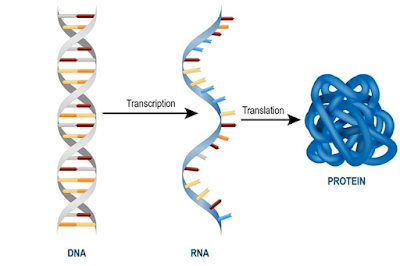Where are we going with this? The information on this page should increase understanding related to this standard: Demonstrate how DNA sequence information is decoded through transcriptional and translational processes within the cell in order to synthesize proteins. Examine the relationship of structure and function of various types of RNA and the importance of this relationship in these processes.
The goal of protein synthesis is to make a protein. In other places, we have discussed that proteins do a wide variety of functions in the body and/or are expressed as a trait. We have also explored how the protein synthesis process begins in the nucleus of a cell with the transcription process.
1. Transcription is the step in protein synthesis where DNA makes mRNA.2. This process takes place in the nucleus.3. After transcription, the cell has a long strand of mRNA that serves as a messenger between the nucleus (DNA) and the ribosome (protein).4. But, before translation, the cell edits the mRNA sequence.4a. Introns are the sequences that were cut out. (The invaders, intruders, the invasive code…)4b. Exons are the sequences that were left in. (The expected code that will be expressed in the protein.)5. When the strand has been edited, the cell splits up the bases into groups of three.6. Each group of three bases is called a codon.7. Each codon codes for an individual amino acid.7a. When these are put together (in a specific order), they make up a specific protein.
That's pretty much it! But… Let's look at it again with pictures and more words!
After transcription, it is time to begin the process called translation.
You can think of it this way… in transcription, the DNA code is copied—transcribed. Then, the code has to be translated from the letters (A, U, C, and G) into a specific sequence of amino acids.
Okay… at the end of transcription, the cell has an edited strand of mRNA. Translation is the step that takes the mRNA code and turns it into a protein.
Translation occurs at the ribosome. (Sometimes, you'll see it described as "on" the ribosome.)
Wazzat?
- mRNA travels to the ribosome to wait for tRNA.
- tRNA transfers the anticodon and the appropriate amino acid to the mRNA sequence.
- Amino acids are joined together with peptide bonds by the ribosome to make a protein.
(Amino acids make up a protein)
Since the mRNA has a specific sequence of codons, then tRNA MUST line up in a specific sequence dragging their specific amino acid along with them. The result is that the amino acids line up in a specific sequence. And… that specific sequence determines which protein is made.
Having used the analogy that a protein is a sentence and the amino acids are the alphabet, you can imagine what might happen if you switch some of the letters around.Who is the girl going to marry?
How is the girl going to marry?
The boy was forced to give up his file.
The boy was forced to give up his life.
In the cases above, the two "proteins" made are not the same!
- Chemicals
- Pollutants
- Radiation
- Sunlight
- DNA replication
- protein synthesis.
 |
| Source, 2022-02 |
Ex: ABCDEF ABBCDEFEx: ABCDEF ACDEF















No comments:
Post a Comment